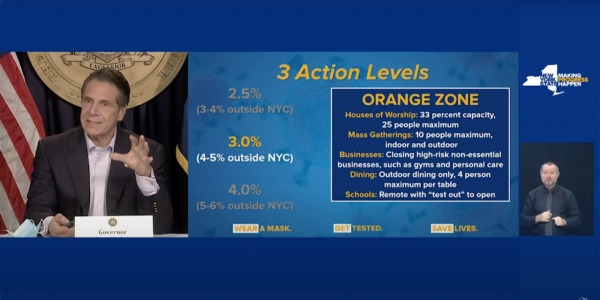
WINDSOR TERRACE — On Nov. 18, Mayor Bill de Blasio announced New York City public school buildings would temporarily close and move to remote learning the following day. The percentage of citywide positive tests exactly hit three percent that morning, using a seven-day rolling average.
In spite of the city’s announcement, Superintendent of Catholic Schools Dr. Thomas Chadzutko, again, reassured families, faculty, and staff that parish schools and Catholic academies in Brooklyn and Queens would continue to remain open and provide in-person learning.
“Every member of our school community has truly dedicated themselves to keeping our schools as safe as possible in the wake of this coronavirus pandemic, and the results prove these efforts have worked,” Chadzutko said on Nov. 15. “For more than eight weeks, we have been able to maintain in-person learning for our students, mostly five days a week, and we intend to keep doing so going forward this school year. We know how critical it is for the development of our students to keep our schools open.”
Public school buildings could reopen as early as Thursday, Dec. 3 — although a reopening date had not yet been announced by Nov. 23.
“We want to get schools open as quickly as possible,” the mayor told reporters during his Nov. 23 briefing, emphasizing that parent cooperation and participation with test consent forms will be key.
NYC Could Become Orange
On Nov. 18, Governor Andrew Cuomo warned New York City could become a state-imposed orange zone. The city had not been classified as orange as of Nov. 23, although cases in Upper Manhattan and parts of Staten Island were on the rise.
However, Cuomo clarified on Nov. 22 that, should the city become orange, schools can go fully remote or mass test its students and reopen, after a few days of closure to sanitize the buildings. Houses of worship would need to limit its occupancy to 25 people, indoor and outdoor gatherings would be limited to 10 people, and dining would be restricted to takeout and outdoor only with four people per table.
“We know we’ll be in an orange zone, again, as early as next week,” de Blasio said during his Nov. 23 briefing, “We’re ramping up right now, retooling our testing operation to go focus on the schools we would reopen first. Again, that begins with District 75 with our special education schools because it is more intensive testing.”
Catholic School Testing, Funding Moving Forward
Twenty-five percent of red- and orange-zone school communities and 20 percent of yellow-zone school communities — including on-campus students, faculty, and staff — must be randomly tested every week. If a weekly random sampling generates at least nine positive cases, schools will have to close and transition to remote learning again.
Though the state has provided free test kits, testing costs in Catholic schools range between $2,000 and $10,000 per week, according to Chadzutko. Those costs are currently being shouldered by each school whose budget is already stretched.
The diocese continues to ask the state for funding to administer these tests and is working on a grant application to help cover costs. However, it also received word from the Department of Health in mid-November that schools currently in yellow zones will no longer be required to have testings if, over the course of two weeks, each individual school’s positivity rate is lower than the yellow zone positivity rate.
Remain Vigilant Over the Thanksgiving Break
Schools across the diocese will begin their annual Thanksgiving recess on Wednesday, Nov. 25, and will return to in-person learning on Monday, Nov. 30.
The Superintendent’s Office, as well as principals, teachers, and staff, continue to encourage and implement strict adherence to the important “Core Four” actions that help prevent COVID-19 transmission. Those actions include maintaining a physical distance of six feet, wearing a face covering, practicing healthy hand hygiene, and staying home if sick. Other daily screenings, including temperature checks and questionnaires, continue to take place prior to entering the building.
